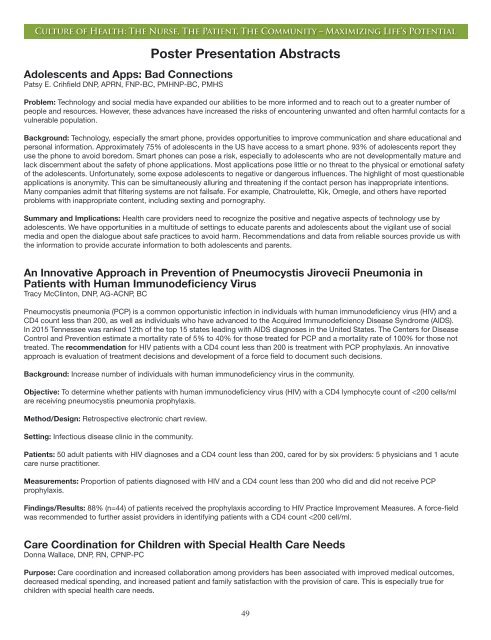2016 TNA–TASN Joint Conference
Create successful ePaper yourself
Turn your PDF publications into a flip-book with our unique Google optimized e-Paper software.
Culture of Health: The Nurse, The Patient, The Community – Maximizing Life’s Potential<br />
Adolescents and Apps: Bad Connections<br />
Patsy E. Crihfield DNP, APRN, FNP-BC, PMHNP-BC, PMHS<br />
Poster Presentation Abstracts<br />
Problem: Technology and social media have expanded our abilities to be more informed and to reach out to a greater number of<br />
people and resources. However, these advances have increased the risks of encountering unwanted and often harmful contacts for a<br />
vulnerable population.<br />
Background: Technology, especially the smart phone, provides opportunities to improve communication and share educational and<br />
personal information. Approximately 75% of adolescents in the US have access to a smart phone. 93% of adolescents report they<br />
use the phone to avoid boredom. Smart phones can pose a risk, especially to adolescents who are not developmentally mature and<br />
lack discernment about the safety of phone applications. Most applications pose little or no threat to the physical or emotional safety<br />
of the adolescents. Unfortunately, some expose adolescents to negative or dangerous influences. The highlight of most questionable<br />
applications is anonymity. This can be simultaneously alluring and threatening if the contact person has inappropriate intentions.<br />
Many companies admit that filtering systems are not failsafe. For example, Chatroulette, Kik, Omegle, and others have reported<br />
problems with inappropriate content, including sexting and pornography.<br />
Summary and Implications: Health care providers need to recognize the positive and negative aspects of technology use by<br />
adolescents. We have opportunities in a multitude of settings to educate parents and adolescents about the vigilant use of social<br />
media and open the dialogue about safe practices to avoid harm. Recommendations and data from reliable sources provide us with<br />
the information to provide accurate information to both adolescents and parents.<br />
An Innovative Approach in Prevention of Pneumocystis Jirovecii Pneumonia in<br />
Patients with Human Immunodeficiency Virus<br />
Tracy McClinton, DNP, AG-ACNP, BC<br />
Pneumocystis pneumonia (PCP) is a common opportunistic infection in individuals with human immunodeficiency virus (HIV) and a<br />
CD4 count less than 200, as well as individuals who have advanced to the Acquired Immunodeficiency Disease Syndrome (AIDS).<br />
In 2015 Tennessee was ranked 12th of the top 15 states leading with AIDS diagnoses in the United States. The Centers for Disease<br />
Control and Prevention estimate a mortality rate of 5% to 40% for those treated for PCP and a mortality rate of 100% for those not<br />
treated. The recommendation for HIV patients with a CD4 count less than 200 is treatment with PCP prophylaxis. An innovative<br />
approach is evaluation of treatment decisions and development of a force field to document such decisions.<br />
Background: Increase number of individuals with human immunodeficiency virus in the community.<br />
Objective: To determine whether patients with human immunodeficiency virus (HIV) with a CD4 lymphocyte count of

















